 W
WFileWare floppy disk drives and diskettes were designed by Apple Computer as a higher-performance alternative to the Disk II and Disk III floppy systems used on the Apple II and Apple III personal computers. The drives are also referred to as Apple 871 drives in service documentation, based on their approximate formatted storage capacity in kilobytes, but are most commonly known by their code name, Twiggy, after the famously thin 1960s fashion model.
 W
WThe Apple IIe is the third model in the Apple II series of personal computers produced by Apple Computer. The e in the name stands for enhanced, referring to the fact that several popular features were now built-in that were formerly only available as upgrades or add-ons in earlier models. Improved expandability combined with the new features made for a very attractive general-purpose machine to first-time computer shoppers. As the last surviving model of the Apple II computer line before discontinuation, and having been manufactured and sold for nearly 11 years with relatively few changes, the IIe earned the distinction of being the longest-lived computer in Apple's history.
 W
WLisa is a desktop computer developed by Apple, released on January 19, 1983. It is one of the first personal computers to present a graphical user interface (GUI) in a machine aimed at individual business users. Development of the Lisa began in 1978, and it underwent many changes during the development period before shipping at US$9,995 with a five-megabyte hard drive. The Lisa was challenged by a relatively high price, insufficient software library, unreliable Apple FileWare ("Twiggy") floppy disks, and the immediate release of the cheaper and faster Macintosh — yielding lifelong sales of only 10,000 units in two years.
 W
WBildschirmtext was an online videotex system launched in West Germany in 1983 by the Deutsche Bundespost, the (West) German postal service. Btx originally required special hardware which had to be bought or rented from the British General Post Office. The data was transmitted through the telephone network using V.23 modems and the content was displayed on a television set.
 W
WThe Lynx was an 8-bit British home computer that was first released in early 1983 as a 48 kB model. Several models were available with 48 kB, 96 kB or 128 kB RAM. It was possible to reach 192 kB with RAM expansions on board. John Shireff designed the hardware and Davis Jansons the firmware.
 W
WThe Canon V-20 was a MSX microcomputer made by the Japanese corporation Canon. It had an innovative digital camera interface (T-90/DMB-90) to use with the Canon T90.
 W
WCasio Databank is a series of digital watches manufactured by Casio. They allow data storage for names and telephone numbers, memos, and in late editions, email addresses; in addition to usually providing a calculator as well as the standard features of a digital watch.
 W
WThe CCE MC-1000 was an obscure Home computer produced in Brazil by CCE. Not much is known about the machine, but it seems clear that it owned its heritage to the Belgian GEM 1000, and the Rabbit RX83 which were systems produced in Hong-Kong by the firm "Rabbit computers”. It was launched a year after the MC 4000, an Apple 2 clone.
 W
WThe Coleco Adam is a home computer and expansion device for the ColecoVision released in 1983 by American toy and video game manufacturer Coleco. It was an attempt to follow on the success of the company's ColecoVision video game console. The Adam was not very successful, partly because of early production problems, and was discontinued in early 1985.
 W
WThe Compaq Portable is an early portable computer which was one of the first 100% IBM PC compatible systems. It was Compaq Computer Corporation's first product, to be followed by others in the Compaq portable series and later Compaq Deskpro series.
 W
WThe Dulmont Magnum was an early laptop computer designed initially by Australian power line equipment manufacturer Dulmison Pty Ltd and subsequently marketed by Dulmont Pty Ltd. Exhibited in September 1983, it was the world's first true battery-powered laptop computer.
 W
WThe Gavilan SC was a laptop computer, and was the first ever to be marketed as a "laptop".
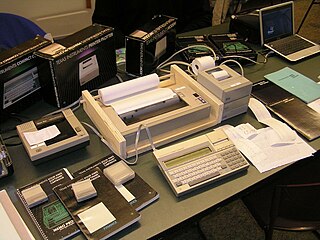 W
WThe Texas Instruments Hex-Bus interface was designed in 1982 and intended for commercial release in late 1983. It connects the console to peripherals via a high-speed serial link. Though it was prototypical to today's USB, it was never released, with only a small number of prototypes appearing in the hands of collectors after TI pulled out of the market.
 W
WThe Hyperion is an early portable computer that vied with the Compaq Portable to be the first portable IBM PC compatible. It was marketed by Infotech Cie of Ottawa, a subsidiary of Bytec Management Corp., who acquired the designer and manufacturer Dynalogic in January 1983. In 1984 the design was licensed by Commodore International in a move that was forecast as a "radical shift of position" and a signal that Commodore would soon dominate the PC compatible market. Despite computers being "hand-assembled from kits" provided by Bytec and displayed alongside the Commodore 900 at a German trade show as their forthcoming first portable computer, it was never sold by Commodore and some analysts downplayed the pact. The Hyperion was shipped in January 1983 at C$4995, two months ahead of the Compaq Portable.
 W
WThe IBM 3270 PC, released in October 1983, is an IBM PC XT containing additional hardware that, in combination with software, can emulate the behaviour of an IBM 3270 terminal. It can therefore be used both as a standalone computer, and as a terminal to a mainframe.
 W
WIBM 5550 is a personal computer series that IBM marketed in Japan, Korea, Taiwan and China in the 1980s and 1990s, for business use customers. In Japan, it was introduced in 1983 and promoted as "Multistation 5550 (マルチステーション5550)" because it had three roles in one machine: a PC, a word processing machine which was traditionally marketed as a machine different from a PC in Japan, and an IBM-host attached terminal.
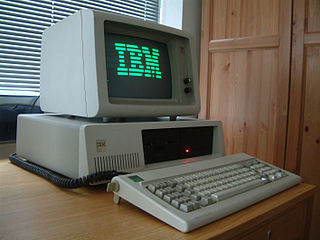 W
WThe IBM Personal Computer XT is a computer in the IBM PC model line, released on March 8, 1983. Except for the addition of a built-in hard drive and extra expansion slots, it is very similar to the original PC.
 W
WThe ImageWriter is a product line of dot matrix printers formerly manufactured by Apple Computer, Inc., and designed then to be compatible with their entire line of computers. There were three different models introduced over time, which were popular mostly among Apple II and Macintosh owners.
 W
WThe Interactive Encyclopedia System, or TIES, was a hypertext system developed in the University of Maryland Human-Computer Interaction Lab by Ben Shneiderman in 1983. The earliest versions of TIES ran in DOS text mode, using the cursor arrow keys for navigating through information. A later version of HyperTIES for the Sun workstation was developed by Don Hopkins using the NeWS window system, with an authoring tool based on UniPress's Gosling Emacs text editor.
 W
WThe educational computer LC80 was a single-board computer manufactured in the German Democratic Republic (GDR) and intended for teaching purposes. It was the first computer that retail customers could buy in the GDR.
 W
WAquarius is a home computer designed by Radofin and released by Mattel Electronics in 1983. It features a Zilog Z80 microprocessor, a rubber chiclet keyboard, 4K of RAM, and a subset of Microsoft BASIC in ROM. It connects to a television set for audio and visual output, and uses a cassette tape recorder for secondary data storage. A limited number of peripherals, such as a 40-column thermal printer, a 4-color printer/plotter, and a 300 baud modem, were released for the unit. It was discontinued in October 1983.
 W
WMSX is a standardized home computer architecture, announced by Microsoft and ASCII Corporation on June 16, 1983. It was initially conceived by Microsoft as a product for the Eastern sector, and jointly marketed by Kazuhiko Nishi, then vice-president at Microsoft and director at ASCII Corporation. Microsoft and Nishi conceived the project as an attempt to create unified standards among various home computing system manufacturers of the period, in the same fashion as the VHS standard for home video tape machines.
 W
WThe NEC PC-100 was a Japanese home computer available on October 13, 1983. It operated on 8086 CPU 7 MHz, 128KB RAM, 128KB VRAM, a Japanese language capable keyboard and a two button mouse. It had three models and its color monitor, PC-KD651, which could be used vertically or horizontally, had the price tag of 198,000 yen. Its biggest advantage over other computers of that time was its high graphical capability of 720 by 512 with a selection of 16 color out of 512 color available on its high end model30. Its OS was MS-DOS and was also equipped with a spreadsheet program Maruchipuran (Multiplan) and a text editor JS-WORD as well as the game Lode Runner.
 W
WThe Nintendo Entertainment System (NES) is an 8-bit third-generation home video game console produced by Nintendo. Nintendo first released it in Japan as the Family Computer, commonly known as the Famicom, in 1983. The NES, a remodelled version, was released internationally in the following years.
 W
WThe Osborne Executive was the planned successor of the already commercially successful Osborne 1 portable computer by Osborne Computer Corporation. The Executive was a collection of the good features from the Osborne 1 and fixed some of its predecessor's flaws.
 W
WThe Philips Videopac+ G7400 is a third-generation home video game console released in limited quantities in 1983, and only in Europe; an American release as the Odyssey³ Command Center was planned but never occurred. The G7400 was the successor to the Philips Videopac G7000, the European counterpart to the American Magnavox Odyssey². The system featured excellently tailored background and foreground graphics.
 W
WThe Casio PV-1000 is a third-generation home video game console manufactured by Casio and released in Japan in 1983. It was discontinued less than a year after release.
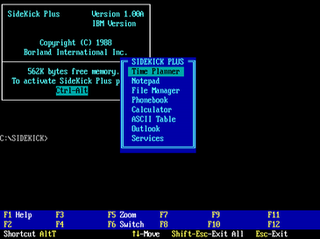 W
WBorland Sidekick was a personal information manager (PIM) launched by American software company Borland in 1984 under Philippe Kahn's leadership. It was an early and popular terminate and stay resident program (TSR) for MS-DOS which enabled computer users to activate the program using a hot key combination while working in other programs. Although a text-mode program, Sidekick's window-based interface echoed that of the Apple Macintosh and anticipated the eventual look of Microsoft Windows 2.0. It included a personal calendar, text editor, calculator, ASCII chart, address book, and phone dialer. According to the prospectus for Borland's initial public offering of stock to the public, Sidekick sold more than 1 million copies in its first three years.
 W
WThe Texas Instruments Compact Computer 40 or CC-40 is a battery-operated portable computer that was developed by Texas Instruments and released in March 1983. Priced at US$249, it weighs 600 grams and can be powered by four AA batteries or an AC adapter. It was intended as a portable business computer, and uses TI's TMS70C20 CPU, an 8-bit microprocessor that runs at 2.5 MHz.
 W
WThe Timex Sinclair 2068 (TS2068), released in November 1983, was Timex Sinclair's third and last home computer for the United States market. It was also marketed in Canada, Argentina, Portugal and Poland, as the Timex Computer 2068.
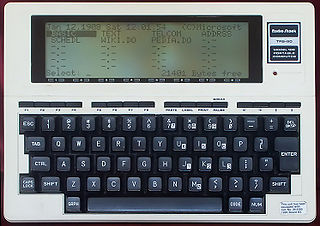 W
WThe TRS-80 Model 100 is a portable computer introduced in 1983. It is one of the first notebook-style computers, featuring a keyboard and liquid crystal display, in a battery-powered package roughly the size and shape of a notepad or large book.
 W
WThe VT220 is an ANSI standard computer terminal introduced by Digital Equipment Corporation (DEC) in November 1983 at a price of $1,395. The VT240 added monochrome ReGIS vector graphics support to the base model, while the VT241 did the same in color. The 200 series replaced the successful VT100 series, providing more functionality in a much smaller unit with a much smaller and lighter keyboard. Among its major upgrades was a number of international character sets, as well as the ability to define new character sets.
 W
WThe VTech Laser 200 was an early 8-bit home computer from 1983, also sold as the Salora Fellow, the Seltron 200 in Hungary and Italy, the Smart-Alec Jr. by Dynasty Computer Corporation in Dallas, Texas for the USA, the Texet TX8000A, and the Dick Smith VZ 200 and the VTech VZ 200.
 W
WThe W65C816S is an 8/16-bit microprocessor (MPU) developed and sold by the Western Design Center (WDC). Introduced in 1983, the W65C816S is an enhanced version of the WDC 65C02 8-bit MPU, itself a CMOS enhancement of the venerable MOS Technology 6502 NMOS MPU. The 65C816 was the CPU for the Apple IIGS and in modified form, the Super Nintendo Entertainment System.
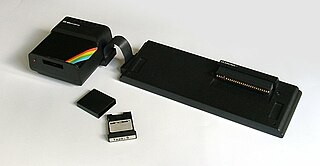 W
WA peripheral from Sinclair Research for its ZX Spectrum home computer, the ZX Interface 1 was launched in 1983. Originally intended as a local area network interface for use in school classrooms, it was revised before launch to also act as the controller for up to eight ZX Microdrive high-speed tape-loop cartridge drives. It also included a DE-9 RS-232 interface capable of operating at up to 19.2 kbit/s. At hardware level it was fundamentally a voltage adaptor, the serial protocol being implemented in software by bit-banging. This led to problems when receiving data, but not when transmitting.
 W
WThe ZX Interface 2 is a peripheral from Sinclair Research for its ZX Spectrum home computer released in September 1983. It has two joystick ports and a ROM cartridge slot, which offers instant loading times. The joystick ports are not compatible with the popular Kempston interface, and thus do not work with most Spectrum games released prior to the launch of the ZX Interface 2. In addition, the pass-through expansion bus provided was stripped, only allowing a ZX Printer to be attached.
 W
WThe ZX Microdrive is a magnetic tape data storage system launched in July 1983 by Sinclair Research for its ZX Spectrum home computer. It was proposed as a cheaper alternative to the floppy disk, but it suffered from poor reliability and lower speed. The Microdrive technology was later also used in the Sinclair QL and ICL One Per Desk personal computers. The minimum storage capacity of a Microdrive tape cartridge was 85 KB.